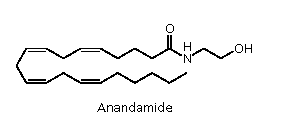

Chocolate contains a substance known as anandamide which is a cannabinoid and is naturally produced in a brain. This chemical is responsible for the narcotic effect of marijuana, which produces a natural high. Anandamide locks itself to the protein receptor THC (tetrahydrocannabinol) on the membrane of cells and triggers a reaction inside the cells that makes us feel high.
Anandamide is broken down fast naturally by the body but chocolate contains two substances, N-oleoylethanolamine and N-linoleoylethaolamine, which are related to the brain lipid anandamide and inhibit the natural breakdown of anandamide, hence preserving the natural high. These substances also target the endogenous cannabinoid system of the brain, mimicking the psychotropic effects caused by plant-derived cannabinoid drugs either directly by activating the receptors or indirectly by increasing the anandamide levels in the brain.
These substances have several effects in humans:
Decease pain perception
change perception of time
decrease hypomobility
produce transient feeling of well being
increase sensory properties of chocolate responsible for craving
Chocolate however contains significantly less anandamide in comparison to marijuana, and hence only a few of the THC receptors are activated and a global high is not achieved.